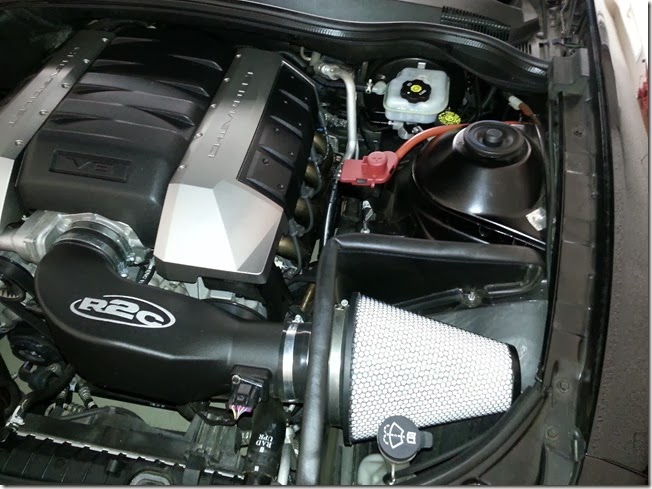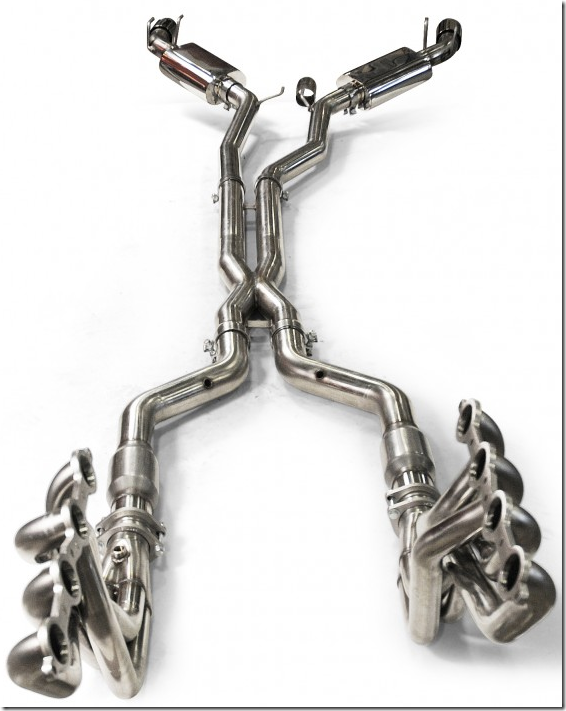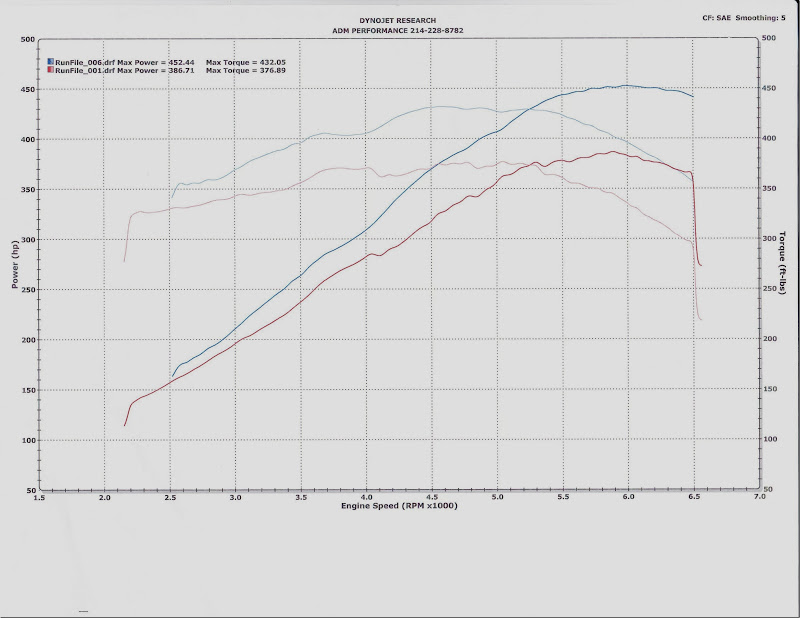New ADM Stage 2 Cam for the SS
Merry Christmas to me! My gift this year was a new camshaft in my Camaro SS. For those unfamiliar, the LS3 V8 used in the manual 6-speed version of the 5th-gen SS is a single cam push-rod motor rated at 426 HP (crank) from the factory. Even in stock form this car is no slouch, but there’s so much more potential in there. It is entirely possible to achieve 500+ rear-wheel horsepower (RWHP) on this motor keeping it naturally aspirated (no turbo, blower, etc). Of course certain other concessions may have to be made around drivability, idling/surging issues, poor gas mileage, not to mention $/ HP to achieve those gains. I was looking to increase the power profile of my car while keeping much of the stock drivability; the best of both worlds.
ADM Performance in Lewisville, TX, owned and run by Andy Mages, did an awesome job delivering exactly what I wanted: common sense gains without sacrificing drivability. The ADM stage 2 cam grind spec, created by Andy, is a 224/230 degrees of total duration (intake/exhaust), .581/ .592 valve lift with a 114-degree lobe separation angle (LSA). Specs like these are considered by most to be characteristic of a mild cam and have been used since the LS1 days. The graphic below from Comp Cams shows the basic elements of a cam in relation to how it interacts with the motor’s valve train. Ultimately, the cam controls how much air and fuel enter/exit the motor and when, so it has huge implications as to how the motor functions. Radically changing these geometries can trigger additional changes in the valve train like push rods, rockers and valve springs. The other obvious aspect that the cam controls is the sound of the exhaust note to some degree and namely the choppiness of the idle. This cam provides a nice bit of idle chop without going overboard.

Having been to a few performance shops over the years, ADM’s is one of the cleanest I’ve ever seen and Andy is a very down to earth guy who will talk you through anything. Andy has been building and upgrading high-performance LS motors for years on his own after coming from Lingenfelter Performance. He is so comfortable with the Camaros and Cadillac CTS-V platform that he actually removes the entire motor from the car for almost every build. This allows him to power wash the motor clean to identify any potential problem areas, as well as provide easy access to perform any additional upgrades while the motor is out: heater hose replacement, coil-overs, T-stats, pulleys, race scoops…whatever. I opted for the heater hose replacement which cleans up the engine bay a bit and he includes a 160-degree t-stat with every build, if you don’t have one already.
With the ADM stage 2 cam, the base circle size doesn’t change from stock, so stock pushrods and rocker arms can be re-used but valve springs do need to be upgraded. Andy also recommended re-using the stock timing chain and oil pump. These are common items to be replaced during cam installs, but if not carefully considering the impacts they have on the overall motor, they can cause additional problems. The stock cam is a single bolt model while the upgrade has 3 bolts which requires a 3-bolt cam timing gear as well. Andy also replaces the stock timing chain tensioner (known for early failure and breakage) with a more robust damper similar to what comes stock in the LS7.


Other items of note include that ADM runs 15w50 synthetic in every build which is what Lingenfelter uses. This oil has a higher zync and phosphorus concentrations than the 10w and 5w variants, so helps with break-in of the new cam plus is better suited to high-performance motors. In fact, if you read the Mobil 1 product guide, the 15w50 oil is specifically recommended for high-performance vehicles. Andy also prefers the AC Delco oil filters for these cars (PF48).
Performance Results
Ok, on to the good stuff. Going in I already had a R2C cold air intake, Kooks 1 7/8” stainless long-tube headers and full 3” exhaust but no tune yet. I installed the headers and exhaust ~9 months ago on jack stands in my garage, which sound incredible by the way. Here you can see the R2C intake with the header primaries peaking out from the right side of the motor.

Kooks makes a pricey but extremely high-quality product that is not difficult to install if you know your way around cars. If you can afford it, this is the kit to get! I’ve done headers before on a previous F-Body but this time it took 6 hours flat, by myself with no lift. Not bad. This system is full stainless, mandrel-bent, 3”, high-flow catted, with mufflers and tips. 100% clamped so no welding required!! It sounds absolutely incredible and with the cam, heads turn everywhere I go (more so than before). See the bottom of this post for a sound clip.
On the dyno, before the cam with no tune, my numbers were merely ok at 386 RWHP/ 376 RWTQ (Rear Wheel Torque). 15% drive train loss is customary through a manual transmission so that puts my before-cam marketing crank horsepower number at 444 HP. That means that my intake and full exhaust with no tune netted 18HP over stock. :-/ This should show how important it is to get tuned if you do headers!
After the cam and tune the car made 452 RWHP/ 432 RWTQ which he says is the 2nd highest horsepower he’s seen on this cam. The highest ever was 455 RWHP, so I was very close. This puts my crank HP number at 520 HP! That’s 94HP over stock with an intake, exhaust, cam and tune. Bad.ass.! And you can definitely feel the difference. Traction becomes an issue dumping this much extra HP into a car suddenly but it’s manageable and incredibly fun.
Here is a low LQ phone vid of the final dyno run:
Other notes of interest:
- I considered doing this cam swap on my own but am very glad I didn’t! There’s just so much to benefit from by someone who has done this a time or 50. Tensioner clip, problems caused by new timing chains, oil pumps, etc. I would have replaced it all and potentially caused more problems down the road.
- If the base circle of the cam is not changing, you can reuse many stock parts which are high quality! Pushrods, rocker arms…
- The forums have many people who have replaced their oil pumps for failures of some kind or another. Many suspect breakage from another part clogging the ports. Andy says he has never actually seen this in a customer car and reuses the stock pump all the time without issue.
- Some of these cars have an oil cooler leak problem. More of a slow drip and an annoyance, not incredibly serious. This is a warrantable item but many still have this problem after warranty replacements.
- Even though Kooks claims to be 49-state legal, by moving the rear O2s closer in, they will still eventually throw a code and have to be tuned out. Par for the course with long tubes.
- The Kooks system sounds amazing but drones BIG time at 1800-1900 RPM. Sadly that range is pegged doing 80mph in 6th gear.
- In addition to tuning for performance, other items included by default include: rear O2 removal, disable torque mgmt, disable skip-shift (CAGS).









No comments: